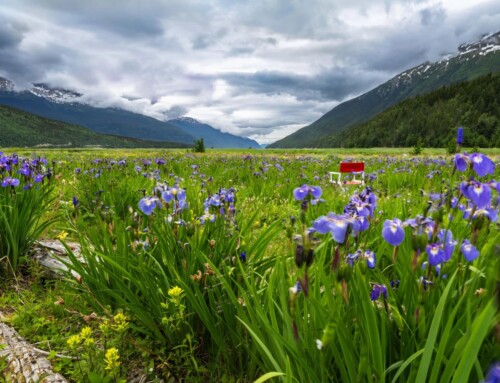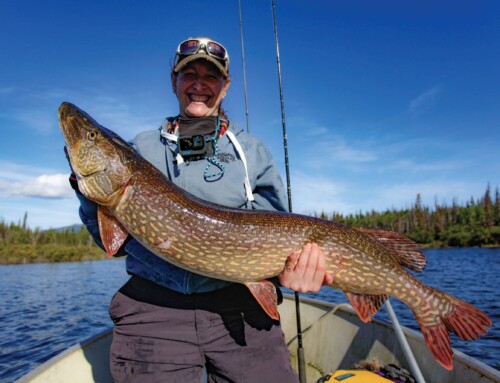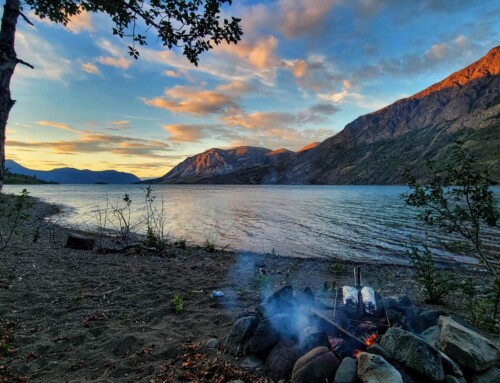BY ANDREW CREMATA
Where have our winters gone? In the not-too-distant-past the idea of fishing the Yukon lakes in April was nothing more than a passing daydream. Throughout May I would keep my fingers crossed, hopeful that there would be some fishable breaks in the ice by Memorial Day Weekend. Most of the time I ended up disappointed.
For two years I’ve been able to work ice-free shorelines in mid-April, enjoying sunshine and warmth that made me think I had time travelled to mid-summer. This is all uncharted territory, and a number of fellow Skagwegians have asked me whether the weather has affected the fishing.
My April forays into untamed trout territory have been wonderful, but they haven’t resulted in so much as a bite. While trout and grayling move into shallow water to feed during the early spring months, this is only because it’s where they’re able to find food.
Hidden among the rocks that lay just submerged along the shoreline are all sorts of insects just waiting for their chance to make a mad dash for the surface. As the rivers and creeks begin to swell, crawling bugs of all varieties will be swept up by the current and carried to the lake. Smaller trout and grayling will then move into the shallows to take part in the springtime banquet.
In the narrow fringe between land and water is where much of this action takes place. The bellies of these early fish are often filled with a cluster of tiny insects and nymphs, confirming that water and land are symbiotic. Life on the edge is thriving, and competition is fierce, which is why larger predators are drawn toward this melee to dine on the distracted. This includes large trout that surge from the deep and bears that climb down from the mountaintops.
Then there is me, toes in the water and heels on the earth, standing on that thin line where worlds converge.
What have I learned about April fishing? Just because the lake is free of ice does not mean the insects have hatched or the rivers and creeks have swollen, proving the lament of all frustrated fisherman, “If there isn’t any bait, there aren’t any fish.”
Not all is lost. Even a short, mild winter in Alaska is still a time of prolonged waiting. So, there’s no reason to complain about the lack of fish when you get to enjoy an extra month of angling.
On my first trip to the Yukon this year, I had little expectation of finding fish. Last April, I learned the lessons outlined above, and even ran into two caribou that seemed bewildered by my presence on a remote rocky shore. It seems that even wildlife is unprepared for the effects of shorter winters.
With no wind and warm air, I cast a small spoon into the shallows and retrieved it slowly. A male northern harrier caught my attention as it glided just above the treetops in search of food. The tips of its pale-grey wings looked like they had been dipped in jet-black paint, forming a shallow V-shape as it turned and twisted effortlessly between clearings.
There was another bird out on the lake, but it was too far away to identify. I squinted in a vain attempt to define its shape, but my glasses were spotted from fine spray that misted from the reel as I turned the handle.
I hadn’t yet seen an insect or any indication of fish in the lake. I resigned myself to the fact that there was little chance of catching a trout. A lonely moth fluttered by, clumsily bouncing along unseen air currents en route to the protection of the woods. I felt similarly out of place as I shook the grass from my lure and prepared for my third cast.
Suddenly, there was a massive splash to my right, followed by a deep guttural noise that instantly made me think, “bear!” I swung my head around, reaching instinctively for my bear spray, when I saw a massive bull moose swimming in my direction. Only its head was visible above the water, it’s ears comically poking upward into a V-shape and bearing an uncanny resemblance to the wings of the harrier.
A barking black dog appeared on the jetty where the moose had entered the water. The moose was obviously no fan of canines. When my dog Rufus saw that massive floating head grunting and groaning in the agitated water, he also started to bark. I picked him up in preparation for a hasty retreat, but the moose turned away with an exasperated groan and continued swimming north. “Poor moose,” I said to Rufus. “He’s probably wondering where all of these dogs came from.”
I watched the moose until all I could make out was the V-shape of its ears in the distance. Meanwhile, I continued my fruitless fishing effort, wondering how the encounter would have gone if I’d been fishing out on the jetty. As the moose made landfall on a distant stretch of shoreline, I noticed a large black rock about a half-mile away. When the black rock started moving, I decided it was time to try another spot.
Late last October, mild weather made it possible to try another novel experiment. This is well past the time when I would normally consider fishing the Yukon Lakes, usually because ice will form in the eyelets of the fishing rod and my fingers will feel like their falling off of my hands.
After waking to an unseasonably calm, warm day, I tossed my gear in the car and drove up to the lakes, fully expecting to come home empty handed. After 30 minutes of working a shallow half-moon shaped inlet between two large rock outcroppings, I got my first bite. Thirty minutes later I had reached my limit of trout, both around 24 inches long.
Predicting the weather is a fool’s errand, but there is a lot to be said for taking advantage of a longer fishing season. Whether the changes in climate are permanent or a passing phase means little within a landscape that is still in its infancy.
Has the weather affected the fishing? I will only be able to answer the question upon further research.






Leave A Comment